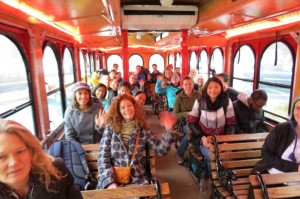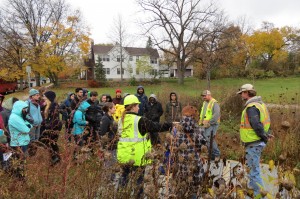
On a dreary Halloween morning a group of 20 intrepid University of Michigan students, boarded a trolly for a whirlwind tour of locations in Ann Arbor that show how one city is preparing for a changing climate. Guided by myself and two colleagues from the City of Ann Arbor, Jen Lawson and Jamie Kidwell, the group heard stories and learned of strategies for protecting homes from flooding, trees from dying, and residents from suffering from heat and cold related health issues and high energy costs.

As a society we still need to do everything in our power to reduce the greenhouse gas emissions that are fueling global climate change. At the same time, we are already experiencing the impacts of a changing climate which are certain to continue into the future even if greenhouse gas emissions stopped tomorrow.
In the Huron River Watershed, arguably the most potentially damaging trends we are seeing in our weather patterns are larger rainfall events and more frequent and longer high heat events. Larger storm events cause flooding and overburden or damage important infrastructure (stormwater systems, dams, water utilities, roads, homes and businesses). Consecutive high heat days are a significant threat to human health and can cause droughts and brownouts. Actions that reduce the impact of these changes can be considered climate adaptation actions, or actions that build resilience to climate change.
Ann Arbor and Washtenaw County have started making investments now that help prepare for these changes. A few examples:
- The City has conducted a detailed analysis predicting where flooding is likely to occur which is helping prioritize stormwater management decisions like where pipes need replacing and where green infrastructure (like rain gardens) can help
- Washtenaw County has recently adopted new rules requiring additional infiltration and detention of rain water for new and re-developments protecting our river from erosion, pollution and risk of damaging floods
- Ann Arbor’s Green Rental program is helping improve energy efficiency in low income areas making staying cool or warm during extremes more affordable
- The Urban Forestry and Community Forest Management Plan identifies areas that are in need of shade trees to provide cooling and recommends species likely to survive more climate extremes
The City of Ann Arbor has recently released a series of climate videos that share more about why this work is a priority and what is being done. Here is the one on extreme storms:
Check out all four videos at a2energy.org/climate.
The students learned a lot about what is going on in their own backyard. I hope these links help you do the same. All aboard!



